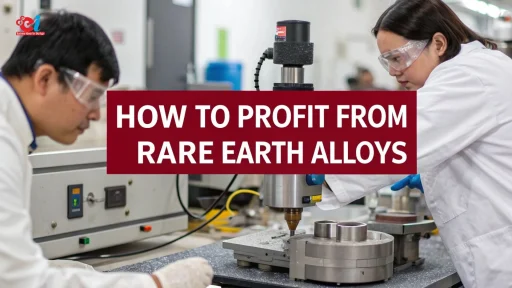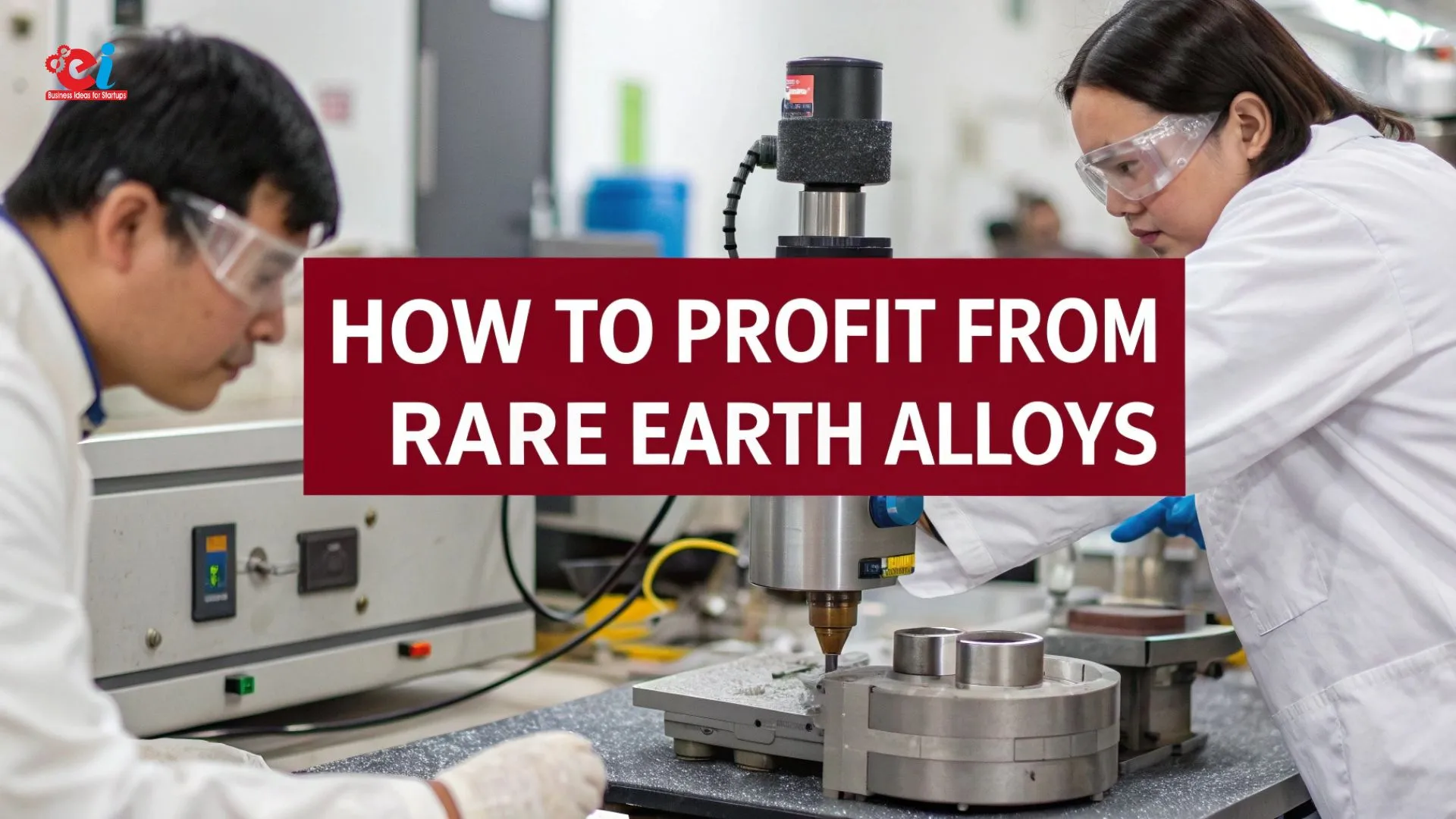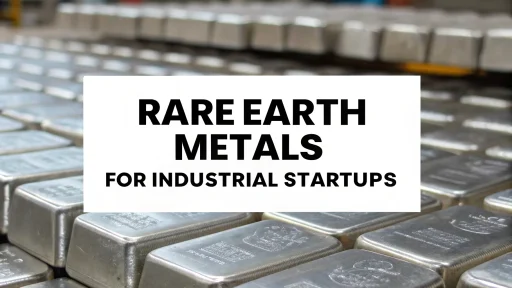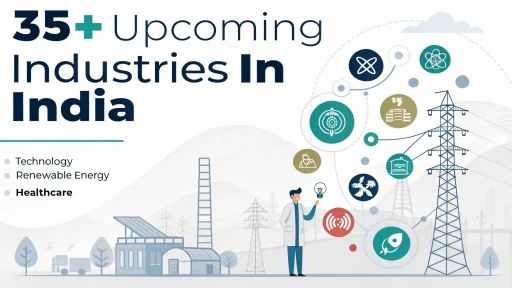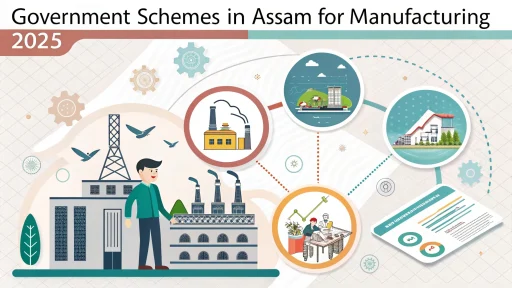Alloys of the rare earth metals are not just unknown bit of substances; rather, they form the basis for some of the most profitable and rapidly growing industries in the world. They are critical for electric vehicles and advanced materials for modern military equipment. The unprecedented rise in demand has turned this region into a business and entrepreneurial opportunity gold mine. This article aims to devise an actionable strategy that will allow one to understand this sector as well as profit from it while relying on insights from the renowned Handbook on Rare Earth Metals & Alloys – Properties, Extraction, Preparation & Applications.
This book is not only meant to be a technical handbook; rather, it aims at helping one penetrate a very niche and high-value market through commerce. If you are planning to explore new avenues of investment, investing in rare earths will certainly pay off due to its practical knowledge toolkit provided by this book.
All You Need to Know about Rare Earth Alloys
Rare earth alloys are formed when rare earth elements like neodymium, samarium, and dysprosium are fused with metals such as iron, cobalt, or boron. These alloys form the backbone of high-performance magnets and advanced electronics as well as sophisticated lasers, nuclear reactors among other applications.
They possess unmatched optical, thermal, and magnetic qualities which make them critical components for a wide range of industries. A classic example is neodymium-iron-boron magnets which drive modern electric motors because of their excellent power-to-weight ratio together with stable performance at higher temperatures.
The commercial side might be straightforward however the intricacies that come along with these alloys is highly advanced: there is little to no substitute for rare earth alloys, they command an unwavering demand accompanied by dire need providing a steady supply stream around the world regardless of price.
For Complete Details, Get The Book Here.
Market Demand and Growth Potential
Recent years have witnessed the sharpest rise in the sales of rare earth items and their alloys coupled with positive predictions for future growth regression lines. This prediction stems from drastic increases in green energy systems, defense research programs alongside surges in electric vehicle supply. Coupled efforts will push market projections beyond $37 billion by the year of 2030 while yielding consistent Compound Annual Growth Rates (CAGRs) between 8% to 12.8%.
In 2023, the use of magnets accounted for over a quarter of the world’s magnet production. Sub-sectors that consume the largest amounts include wind turbines, consumer electronics, and motors for hybrid vehicles. This sharp increase in reliance on rare earth alloys is giving many companies reasons to invest greater resources into finding secure long term sources—and that is where they can create real profit.
Global Supply Chain & China’s Dominance
Any discussion on rare earth alloys must also address the overwhelming dominance China holds. With more than 80 percent of these countries’ processing facilities, China virtually monopolizes the supply chain. This has led to recurring restrictions on exports because brisk demand for motors used in electric vehicles and military-grade materials has surged globally.
These developments pose a risk for entrepreneurs. They are willing to accept contracts and grants from other countries such as India, Australia or even the United States who will help them remove themselves from China’s stranglehold with independent supply lines. Change creates an investment opportunity aimed at innovation in recycling processes or lowering the costs for domestic sourcing which would allow access to new players looking to process contracts freely without being controlled by other powers.
Related: Rare Earth Metals for Manufacturing: Business Handbook
Opportunities for Business in the Rare Earth Alloys Industry
The rare earth alloy industry offers multiple entry points for businesses. The most costly option that could yield high rewards is investing directly in mining and ore extraction. However, the recycling of electronic waste and magnets is a less costly alternative that provides quicker returns.
Alloy formulation, technical consulting, or contract manufacturing are examples of niche services which can be profitable. Each stage from ore to finished alloy is thoroughly discussed in The Handbook on Rare Earth Metals & Alloys, making it an ideal resource for establishing pilot facilities or negotiating joint ventures.
Moreover, professionals with experience in rare earth materials of trade compliance have opportunities to develop profitable business models in supply chain logistics, environmental services, and specialized testing laboratories.
Profits and Economics Of Rare Earth Alloys
Increased demand allows efficient extraction and processing methods to lead to higher profitability than conventional alloys. Prices for neodymium oxide doubled between 2020–2023 because of restrictions on supply chains. While their overall usage may be low, smCo magnets sell significantly due to extreme durability during harsh environmental conditions.
With optimized operations, profit margins from alloy production and rare earth refining can be as high as 20–30%—more in regions with tax breaks or grant funding for clean energy ventures. The same goes for manufacturers of electric vehicles who scramble to secure the raw material supply; businesses that produce consistent ultra-pure alloys stand to gain long-term, high-value contracts.
Exploring Niche Applications
Alloy’s applications range across many sectors, especially with electric vehicles leveraging neodymium and dysprosium in their motors. And while electric vehicles are one of the more well-known uses, these alloys have found application in aerospace, telecommunications, medical imaging and even clean energy.
In aerospace, samarium-cobalt alloys are invaluable for guarding missile systems and aircraft engines against thermal corrosion breakdown. In healthcare, gadolinium-based alloys aid MRIs both for imaging and contrast enhancement servicing. These technologically advanced applications not only provide financial rewards because of their specialized nature but also position entrepreneurs aligned with businesses seeking dependable suppliers of top-tier alloys.
Innovation and Value-Added Manufacturing
An alternative approach to profitability is shifting from merely extracting resources to engaging in value-added manufacturing. The production of finished goods such as magnets, high-purity alloy components, or specialty compounds like mischmetal offer significant profit margins.
Due to advancements made in sintering, crystal structuring, and grain alignment, businesses can now provide stronger and more durable alloys specifically designed for certain industries. Additive manufacturing is also aiding the development of rare earth alloys with intricate geometrical shapes, which are useful in defense and aerospace industries.
In order to enhance operational efficiency and product quality, the Handbook on Rare Earth Metals & Alloys provides detailed strategies on equipment and processing parameters along with end-use specifications that can greatly improve workflow.
Circular Economy and Sustainability
From the perspective of the entire industry, one of the most important concerns is relative rarity sustainability. These challenges are especially prevalent within recycling opportunities alongside circular economy initiatives.
While the stock of electronic waste is on the rise, as are old wind turbine magnets, less than 1% of rare earth materials get recycled. This figure shows to how solvent extraction, ion exchange and pyrometallurgical recovery technologies can remove high purity remanent rare earths from discarded products. Indeed, it is entrepreneurs that can work in this sector.
Developing self-consciously recovering projects might do retrospectively prove profitable while helping save the planet. The handbook describes best practices for the whole cycle including safety protocols, chemicals handling and efficiency metrics on processes so anyone focused on doing well by doing good should jump at that opportunity.
Related: Rare Earth Alloys for Industrial Startups
Key Challenges and Risk Management
Rare earth alloy ventures undergoing such enterprises should be ready with precautionary measures as profit potential comes their way. The everchanging market remains a top threat followed closely by exports from China since these two control pricing policies for certain rare earth elements due to being geopolitically centered at times.
Long term collaboration approaches together with measurable loss targets counter lowered output claims while maintaining sustainable policy adaptivity allowing nimbleness with strict compliance change embrace. Transparent traceability alongside strongly monitored set standards builds in trust while allow better positioning resilience through shiftable business model cycles decisive hits.
Strategic Approaches to Maximize ROI
In this industry, strategic thinking is a must. One way to improve savings and efficiency is through vertical integration where a business manages the full process of production from the procurement of raw materials to the sourcing of alloys. It also enables better control over the supply chain. Collaborations with automotive OEMs or other renewable energy companies, as well as government partnerships, can ensure constant demand for these products.
Geographic diversification also shows promise. India, Australia and other countries are increasing their rare earth capabilities and attracting both foreign and domestic investors. Establishing operations in these emerging markets can provide businesses access to local talent as well as favorable government policies.
Why Businesses Need This Handbook
The handbook has been constructed with its readers’ needs in mind using great care. It is more than just a piece of writing that details the technical portions of handling rare earth metals and alloys, this handbook can help entrepreneurs extensively navigate through the business world as it has important pieces of information such as the physical properties as well as industrial uses.
This book enables an entrepreneur to take calculated decisions. It also explains in detail value addition from ore mining and extraction to alloy manufacturing and then market interfacing. This book is equally crucial for those who are aspiring to develop or grow a rare earth industry because it provides information on modern recycling methods, global supply chains alongside product modification.
Grab your copy of the book “Handbook on Rare Earth Metals and Alloys” here
Real-World Business Use Cases
MP Materials is an example which was founded recently who was able to obtain investment contracts and grow within years after learning about aerospace applications of rare earth alloys. It took them half a decade for scaling up production increase. They started with raw material extraction and moved towards magnet production which granted them multi-year deals with American automobile producers. In Europe Neo Performance Materials along with Vacuumschmelze have undergone specialization towards serving different types of companies for manufacture and processing thus catered to defense contractors as well as green tech enterprises.
We see successful smaller businesses focused on e-waste recycling or specialized component manufacturing carving their own mark through targeting niche markets and forming strong ties directly with suppliers or through OEMs.
Government Policies and Incentives
All countries now consider rare earth materials as strategic assets. India’s “Atmanirbhar Bharat” program includes self-sufficiency on rare earths as one of its goals. The US Department of Energy and Department of Defense have grants for domestic production and development activities on rare earths and their ores.
Subsidies, tax credits, and R&D Grants are available to other businesses under national priorities which these rare minerals cater to. Such entrepreneurs who know the workings of these programs, usually captured in the handbook, stand to benefit financially and competitively.
Global Innovation Hubs and Markets
Japan, South Korea, Germany, Australia are emerging as new global centers of innovation in application of alloys for rare earth elements. This is because these countries are starting to fund university-based research, industry-academia consortia, as well as startup accelerators focused on addressing the sustainable solutions for supply chain issues pertaining to rare earth materials.
By using these hubs along with international collaboration contracts with other industrialized nations a company can predict movements in the industry alongside obtaining advanced technology which outpaces the borders for winning markets.
Projecting the Next 10 Years
New technological advancements within the next decade are estimated to significantly alter the rare earth alloy market. Although new sources of supply will become available, demand will outpace manufacturers, causing prices to remain elevated. Furthermore, newer technologies in lightweight alloys, battery chemistry, and magnet design will continue increasing the applicability of rare earths.
Early gaining entrepreneurs who thoroughly adapt and invest early stand to gain. This boom should be looked at as a shift in trend—it’s a long-term industrial change that favors anticipating movement shifts paired with deep expertise.
Final Insights on How to Construct a REE Business
The ability to construct an entire suite of alloy ERM services puts this within reach of countless savvy entrepreneurs looking for expansion. They could build a mining işletmesi business, start a recycling company or provide high-tech consulting services; whatever the option is there is plenty of opportunity here.
In order to successfully take advantage of all aspects of something like this it needs infrastructure applied correctly. That Handbook On Rare Earth Metals And Alloys gives crucial up-to-date information for businesses wanting practical knowledge that addresses future readiness in this area.
This is the moment to take action and make some positive changes. Prepare yourself with the proper tools and information, structure your business accordingly, and capitalize on an ever-evolving market that is defining the future of energy, defense, as well as technology sectors.

